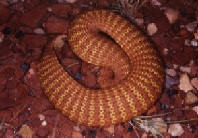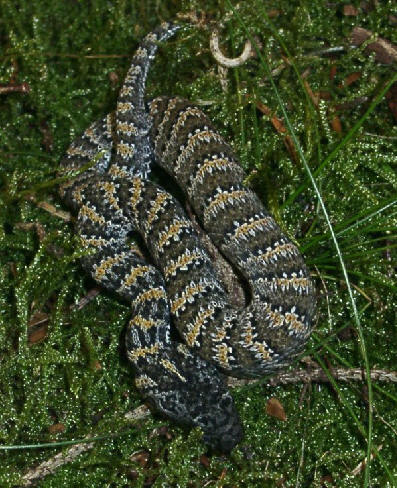Death Adder Snake
|
The Death Adder is native to Australia, New Guinea and nearby islands, and are among the most venomous snakes in the world. Death adders are found in woodlands and forests, wetlands and in nearly every aspect of Australia that is damper and provides some ground cover. They are very good swimmers and can be seen in the water, swimming with a side to side motion that slices through the water rapidly.
Unlike most snakes, Death Adders do not actively hunt, but rather lie in ambush and draw their prey to them. They eat small mammals, birds and reptiles, sometimes other snakes even. They swallow their prey whole. To find the right prey, the Death Adder flicks its tongue in and out, literally tasting the air around them to find the correct size and prey food. They also rely on their keen eyesight, but not to the degree that they find it with their tongues. When hungry, Death Adders bury themselves amongst the substrate. This may be leaf litter, soil or sand, depending on their environment. The only part of themselves they expose are their head and their tail, both generally very well camouflaged. On the end of the tail is a caudral lure which is placed in front of their head, and when shaken/wiggled very quickly is easily mistaken for a grub or worm. An unsuspecting bird or mammal will eventually notice the 'easy lunch' and attempt to seize it. Only then will the Death Adder move, lashing out with the quickest strike of any snake in the world. A Death Adder can go from a strike position, to strike and envenoming their prey, and back to strike position again, in as little as 0.13 of a second, literally in the blink of an eye. Birds of prey and large reptiles eat Death Adders and seem to be too fast to be bitten, or in fact may be immune to the bit.
Death adders are very viper-like in appearance, having a short, robust body, triangular shaped heads and small subocular scales. They also have vertical pupils and many small scales on the top of the head. The maximum length of a Death Adder is 1 metre long. Its fangs are 6.2 millimetres long and are hollow. Despite their name and appearance, they are not vipers at all. This is a case of convergent evolution. It normally takes 2 – 3 years to reach adult size. Females are generally slightly larger than the males. They can also be easily distinguished from other Australian snakes because of a small, worm like lure on the end of their tail, which is used to attract prey. Most have large bands around their bodies, though the colour itself is variable, depending on their locality. Colours are usually black, grey or red and yellow, but also include brown and greenish-grey.
The ambush hunting makes the Death Adder more of a threat to humans. Most other snakes will move away from the first sign of danger whereas death adders tend to sit tight and rely on their camouflage. A stray foot in the wrong place can lead to an extremely rapid strike (probably the fastest of all Australian snakes) and a serious bite. However, death adders really are reluctant to bite unless the threat is very close to them. It lies half buried in the sand, curls up with its head next to its tail. It then dangles its tail in the air to attract rodents like lizards and small birds. The Death Adder rarely misses its prey and it never wastes its venom. Its fangs can rotate forward just in time to strike its prey. Its fangs can be at a right angle to the skin and it can still bite. A Death Adder has 85 milligrams of venom and it strikes its prey as fast as lightning. They inject on average 40 – 100 mg of extremely toxic venom with a bite. This makes an untreated death adder bite one of the most dangerous in the world. A bite from a death adder attacks the nerves and causes paralysis. While this paralysis is very minor at first, it can cause death from a complete respiratory shutdown in as little as six hours. Symptoms peak in 24 – 48 hours. Symptoms of envenomation can be reversed through the use of death adder antivenom, or using anticholinesterases, which break the synaptic blockade by making acetylcholine more available to the parasympathetic nervous system, thus mitigating the effects of the venom. |

